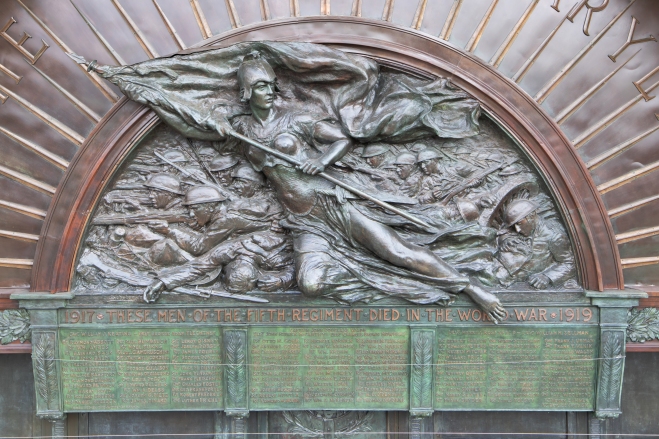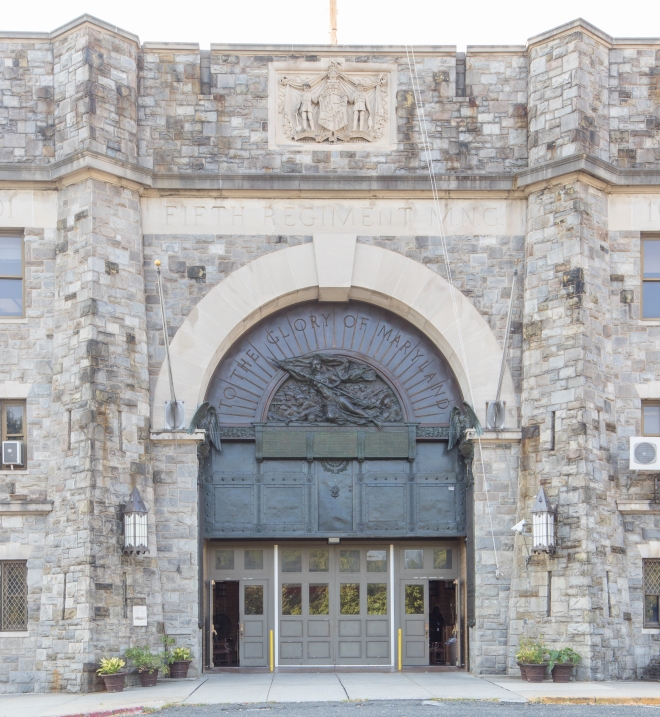By Nancy Kurtz, Commissioner, Governor’s Commission on Maryland Military Monuments

WWI Memorial, Fifth Regiment Armory (photo copyright: J. Brough Schamp)
The magnificent World War I Memorial over the entrance of the Fifth Regiment Armory in Baltimore recently was cleaned and refurbished, the work coordinated by the Governor’s Commission on Maryland Military Monuments and the Department of General Services, and funded by the Maryland Military Department. Last maintained in 2001, the coatings on the bronze and copper elements had weathered and required removal and renewal. Anticipating the 100th anniversary of the United States involvement in World War I and Armistice Day on November 11, 2018, the Commission funded a condition assessment in early 2016 and developed a plan for treatment in cooperation with the Military Department, the agency headquartered at the armory.
The Commission has sponsored or co-sponsored conservation treatment for 112
Maryland monuments, including twenty-five commemorating World War I. Some projects were in partnership with Baltimore City or with the National Park Service. These include monuments at Antietam National Battlefield, Gettysburg National Military Park, and Fort McHenry National Monument and Historic Shrine. Potential projects are evaluated and selected according to condition, historical significance, and artistic merit.

Fifth Regiment Armory in Baltimore (photo copyright: J. Brough Schamp)
In order to preserve the completed work, the Commission manages, on a modest budget, a plan of cyclical maintenance carried out every 3-4 years for sixty of the treated monuments that do not fall under maintenance programs administered by other agencies. The sixty are owned by counties, municipalities and private organizations. Projects are added to the treatment and maintenance program according to need and budget. Maintenance of treated works is key to the success of the program. Performed by professional outdoor sculpture conservators, it typically entails washing the monuments and plaques, touching up the protective wax coatings on bronze, and attending to repair issues that may arise. Because the scope and cost of maintenance of the memorial at the Fifth Regiment Armory exceeded the annual budget of the Monuments Commission, it was funded by the Military Department.
The Fifth Regiment of the 29th Division fought in the Meuse-Argonne Offensive, part of the final Allied offensive and one of the largest in United States Military history. Over 30% of the Division was killed or wounded. This powerful sculpture by Baltimore artist Hans Schuler, dedicated on Armistice Day in 1925, features the allegorical figure of Victory leading the Regiment and comprises actual portraits of men who died at the front. Schuler graduated from the Rinehart School of Sculpture of the Maryland Institute, studied in Paris where he was the first American sculptor awarded the Salon Gold Medal, and was president of the Maryland Institute from 1925 until 1951, the year of his death. The memorial is an outstanding example of the figural bronze sculpture in demand for public art, monuments and private memorials in the early twentieth century.

Deteriorated coatings on the memorial pre-conservation
The inscription, “TO THE GLORY OF MARYLAND,” radiates in brass letters on a copper lunette surrounding the bronze sculptural group. Below the sculptures is an honor roll of those who were lost. Flanking the entrance are tablets carrying the names of those who served, capped with ornate shields and guarded by bronze eagles. The two-story roll-down door is constructed of copper sheet over wood and embellished with decorative cast bronze elements.
The memorial has had a variety of coatings applied over the years, which has hampered ongoing conservation efforts. Chemical methods were not entirely successful in removing underlying layers of paint during the 2001 maintenance. However, in summer of 2018 the deteriorated coatings were removed from the bronze and copper using recently available, highly precise laser technology, which revealed the historic surfaces under the coatings without removing the patina.
Following testing to determine the appropriate level of cleaning, Conservator Andrzej Dajnowski of Conservation of Sculpture and Objects Studio used laser technology to remove deteriorated coatings from the bronze sculptures while preserving the patina beneath (click here to see a video of the process). The new coating of satin finish acrylic will protect the metal surfaces for many years while revealing and enhancing the richness of the colors.

Detail of restored soldiers (photo copyright: J. Brough Schamp)
The final step in the project was installation of new bird netting. Inconspicuous from the ground, it prevents birds from roosting and nesting in the alcove and will protect the memorial well into the future.
Administered by the Department of Planning, the Governor’s Commission on Maryland Military Monuments has developed and implemented the only statewide program of military monuments conservation and maintenance in the country. The Commission was created in 1989 by Governor William Donald Schaefer and is charged with locating, determining maintenance responsibility for, and assisting in preservation of monuments in need. At present count, 468 monuments to Marylanders have been identified, in and out of state. Approximately 100 are owned and under the care of the City of Baltimore, the National Park Service, other federal agencies, or other states. Sixty-one commemorate World War I.

The restored Fifth Regiment memorial (photo copyright: J. Brough Schamp)
The construction of new monuments is ongoing, and many of the monuments date from the mid-to-late 20th century. The Commission is not charged with the creation of new monuments, and those who do so are encouraged to set aside funding for their maintenance. For more information on the work of the Monuments Commission and a guided tour of representative projects, please visit the Commission web page, hosted by the Maryland Historical Trust.
The Governor’s Commission on Maryland Military Monuments and the Maryland Historical Trust are grateful to architectural photographer J. Brough Schamp, who documented the completed project. Mr. Schamp’s photos are copyrighted and used here with permission. For information and permission for use, visit http://www.broughschampphotography.com.
Netting photos are courtesy of BirdMaster, as noted.






